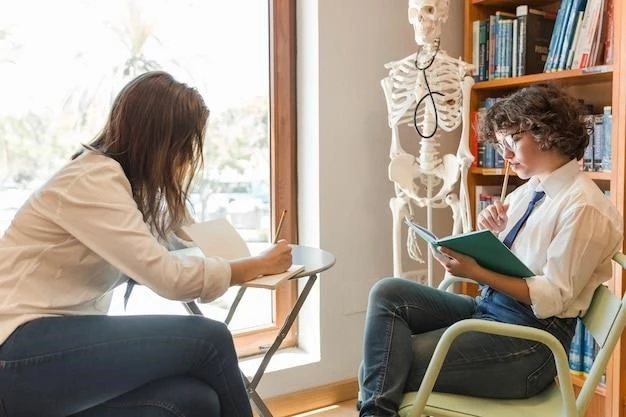Disease ౼ Idiopathic Juvenile Osteoporosis
Idiopathic juvenile osteoporosis is a condition affecting growing children with brittle bones, often due to unknown causes or genetic factors.

Idiopathic juvenile osteoporosis is a rare condition characterized by decreased bone density in children and adolescents. The term ″idiopathic″ means that the cause of the disease is unknown. This condition can lead to an increased risk of fractures and bone deformities in young individuals.
It is essential to recognize the importance of bone health in children, as their bones are still developing. Idiopathic juvenile osteoporosis can significantly impact a child’s overall growth and skeletal system. Understanding the basics of this condition is crucial for early detection, proper diagnosis, and timely intervention to prevent long-term complications.
Parents and caregivers of children with idiopathic juvenile osteoporosis should be aware of the signs and symptoms, seek medical attention if they suspect any issues related to bone health, and work closely with healthcare professionals to manage the condition effectively. By educating yourself about this rare illness, you can better support your child’s bone health and well-being.
Causes and Risk Factors
Idiopathic juvenile osteoporosis is a complex condition with no single known cause. While the exact factors triggering this disease remain unidentified, various risk factors may contribute to its development.
Genetic factors play a significant role in idiopathic juvenile osteoporosis, suggesting a possible hereditary component. Family history of bone disorders or a genetic predisposition to low bone density can increase the likelihood of a child developing this condition. Research indicates that certain gene mutations may impact bone health in growing children.
Other potential risk factors for idiopathic juvenile osteoporosis include hormonal imbalances, nutritional deficiencies, lack of physical activity, and underlying medical conditions that affect bone metabolism. Children who have a sedentary lifestyle, consume a diet lacking in essential nutrients like calcium and vitamin D, or have endocrine disorders may be more susceptible to developing weakened bones.
Understanding the various causes and risk factors associated with idiopathic juvenile osteoporosis can help parents and healthcare providers identify high-risk individuals and implement preventive strategies. By addressing potential risk factors early on and promoting healthy bone development through balanced nutrition, physical activity, and regular medical check-ups, it is possible to minimize the impact of this condition on a child’s skeletal health.
Symptoms and Diagnosis
Recognizing the symptoms of idiopathic juvenile osteoporosis is crucial for early intervention and effective management. In the early stages, this condition may not present visible signs, making regular check-ups and awareness essential.
Common symptoms of idiopathic juvenile osteoporosis include frequent fractures, especially in the spine or long bones, such as the legs or arms. Children may experience bone pain, weakness, and reduced mobility due to fragile bones. Height loss or a stooped posture may also indicate vertebral compression fractures.
Diagnosing idiopathic juvenile osteoporosis typically involves a thorough medical history review, physical examination, and specialized tests. Bone density scans, such as dual-energy X-ray absorptiometry (DXA) scans, can assess bone strength and density. Blood tests to evaluate calcium, vitamin D levels, and other markers related to bone health may also be conducted.
Healthcare providers may consider genetic testing to identify specific gene mutations associated with bone disorders. A multidisciplinary approach involving pediatricians, endocrinologists, orthopedic specialists, and genetic counselors is often necessary to confirm the diagnosis and establish a comprehensive treatment plan tailored to the child’s needs.
Effects on Bone Density
Idiopathic juvenile osteoporosis can have profound effects on bone density, leading to weakened bones and increased susceptibility to fractures in growing children. The condition is characterized by a reduction in bone mass and density, making the bones more brittle and prone to breaks.
Decreased bone density in children with idiopathic juvenile osteoporosis can affect their overall skeletal health and growth. Insufficient bone strength can compromise the structural integrity of the skeleton, impacting posture, mobility, and quality of life. Children may experience limitations in physical activities and may be at a higher risk of sustaining injuries from everyday movements or minor impacts.
Monitoring bone density through regular medical evaluations and imaging tests is essential to track the progression of idiopathic juvenile osteoporosis and assess the effectiveness of treatment strategies. Healthcare providers may recommend lifestyle modifications, nutritional supplements, physical therapy, and medication to address bone density issues and minimize the risk of fractures in affected children.
By understanding the impact of idiopathic juvenile osteoporosis on bone density, parents, caregivers, and healthcare professionals can collaborate to provide comprehensive care and support for children with this condition. Early intervention and proactive management of bone health are crucial to optimizing outcomes and promoting skeletal strength in young individuals affected by this rare illness.
Impact on Skeletal System
Idiopathic juvenile osteoporosis can significantly impact the skeletal system of growing children, affecting both bone structure and function. Weakened bones due to decreased bone density can pose challenges to the overall health and development of the skeleton.
One of the primary concerns related to idiopathic juvenile osteoporosis is the increased risk of fractures, particularly in weight-bearing bones like the vertebrae, hips, and wrists. Fractures in the spine can lead to vertebral compression, causing pain, height loss, and spinal deformities in affected individuals.
The skeletal system plays a crucial role in supporting the body, protecting internal organs, and facilitating movement. Children with idiopathic juvenile osteoporosis may experience limitations in mobility and physical activity due to bone fragility, impacting their quality of life and independence.
To address the impact of idiopathic juvenile osteoporosis on the skeletal system, healthcare providers may recommend comprehensive treatment approaches focused on strengthening bones, preventing fractures, and promoting bone health through lifestyle modifications, exercise, and targeted interventions. By addressing the specific challenges posed by this condition on the skeletal system, children can enhance their bone resilience and support optimal growth and development.
Vertebral Compression and Other Concerns
Vertebral compression fractures are a significant concern in children with idiopathic juvenile osteoporosis, affecting the vertebrae and potentially leading to pain, spinal deformities, and postural changes. These fractures can impact a child’s mobility, height, and overall well-being.
Children experiencing vertebral compression fractures may exhibit symptoms such as back pain, limited range of motion, and reduced height. It is essential to address these concerns promptly to prevent further complications and ensure proper skeletal support.
In addition to vertebral compression, children with idiopathic juvenile osteoporosis may face other concerns related to bone health, including an increased risk of fractures in other vulnerable areas of the body, such as the hips, wrists, and ankles. Fractures in these regions can affect mobility, independence, and daily activities.
Healthcare providers may recommend interventions to manage vertebral compression fractures and other bone-related concerns in children with idiopathic juvenile osteoporosis. These measures may include pain management strategies, physical therapy to improve strength and flexibility, bracing to support the spine, and lifestyle modifications to reduce the risk of fractures.
Treatment Options
When it comes to addressing idiopathic juvenile osteoporosis, a multifaceted approach to treatment is essential to manage the condition effectively and promote optimal bone health in growing children. The goal of treatment is to strengthen the bones, reduce the risk of fractures, and support overall skeletal well-being.
Medical interventions for idiopathic juvenile osteoporosis may include the use of medications to enhance bone density, such as bisphosphonates, which can help slow down bone loss and reduce fracture risk. These medications are typically prescribed based on the child’s individual needs and health status.
In addition to pharmacological treatments, lifestyle modifications play a crucial role in managing idiopathic juvenile osteoporosis. Encouraging regular physical activity, especially weight-bearing exercises that support bone strength, can be beneficial. Adequate intake of calcium and vitamin D through diet or supplements is essential for maintaining optimal bone health.
Physical therapy and specialized exercises can also help improve bone strength, flexibility, and posture in children with idiopathic juvenile osteoporosis. Furthermore, healthcare providers may recommend bracing or orthotic devices to provide additional support to fragile bones and reduce the risk of fractures, especially in the spine.
It is crucial for parents, caregivers, and healthcare professionals to work together to develop a comprehensive treatment plan tailored to the child’s unique needs and to monitor progress over time. By combining medical interventions, lifestyle adjustments, and supportive therapies, children with idiopathic juvenile osteoporosis can achieve better bone health outcomes and reduce the impact of the condition on their daily lives.
Prognosis and Long-Term Outlook
Understanding the prognosis and long-term outlook for children with idiopathic juvenile osteoporosis is essential for managing expectations and planning for the future; While this condition can present challenges, early detection, appropriate treatment, and lifestyle modifications can significantly impact the overall outcome.
The prognosis for children with idiopathic juvenile osteoporosis varies depending on several factors, including the severity of bone loss, the presence of fractures, and the responsiveness to treatment. With timely intervention and adherence to medical recommendations, many children can experience improvements in bone density, reduced fracture risk, and enhanced quality of life.
Long-term management of idiopathic juvenile osteoporosis involves regular monitoring of bone health, ongoing medical care, and lifestyle adjustments to support skeletal strength. Children may need continuous treatment, including medication, physical therapy, and nutritional supplementation, to maintain optimal bone density and reduce the risk of fractures.
By collaborating closely with healthcare providers, parents and caregivers can help ensure that children with idiopathic juvenile osteoporosis receive the necessary support and interventions to promote long-term bone health. Monitoring the child’s progress, addressing any new symptoms or concerns promptly, and fostering a holistic approach to care can contribute to a positive long-term outlook for children affected by this rare condition.
Coping Strategies and Support
Coping with idiopathic juvenile osteoporosis involves a combination of emotional resilience, practical strategies, and support systems to help children and their families navigate the challenges associated with the condition. Building a strong support network and implementing coping mechanisms are crucial aspects of managing this rare disease;
Emotional support plays a vital role in helping children cope with the physical and emotional impact of idiopathic juvenile osteoporosis. Open communication with healthcare providers, family members, and peers can provide reassurance, guidance, and a sense of belonging during difficult times.
Practical coping strategies may include education about the condition, adherence to treatment plans, and fostering a positive attitude towards managing bone health. Encouraging children to participate in activities they enjoy, while ensuring safety and minimal risk of injury, can enhance their overall well-being and confidence.
Support groups and online communities can offer valuable resources, shared experiences, and a sense of community for children and families affected by idiopathic juvenile osteoporosis. Connecting with others facing similar challenges can provide emotional support, practical advice, and a sense of empowerment.
By prioritizing self-care, seeking appropriate medical care, and fostering a supportive environment, children with idiopathic juvenile osteoporosis can develop resilience, adaptability, and a positive outlook on managing their health. Encouraging open communication, access to resources, and promoting self-advocacy can empower children to navigate the complexities of this condition with strength and determination.
